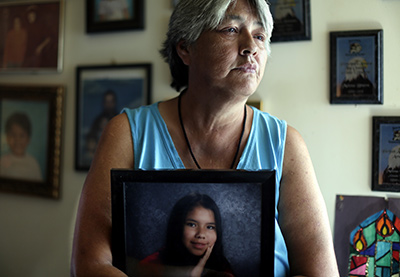2016 Canadian Hillman Prize Winner

MMIW beat reporter: Kathryn Blaze Baum
Investigative reporter: Renata D’Aliesio
Data journalist: Matthew McClearn
Multimedia editor: Laura Blenkinsop
Senior interactive designer/developer: Chris Manza
Reporter: Kristy Hoffman
The 2016 Hillman Prize judges chose three pieces that brought to light critical new information on the subject of missing and murdered Aboriginal women in Canada and contributed to the federal government’s decision to call an inquiry into this tragedy.
In mid-2014, The Globe and Mail set out to investigate the tragedy of Canada’s missing and murdered indigenous women in a way no other media outlet – let alone any level of government – had done before.
The Globe focused its efforts on three critical but under-reported areas: The federal government’s lacklustre plan to link unsolved missing-person cases with unidentified human remains, an approach that trails what already exists in the U.S.; the failures of Manitoba’s foster-care system, specifically its reliance on hotels for temporary placements; and the startling over-representation of indigenous women among Canada’s female serial-killer victims.
 The Globe uncovered that reports on more than 250 unidentified human remains were not in an RCMP-managed database – a gap that has victims’ families wondering if their “missing” loved one is among the unidentified dead. In the wake of the Globe’s investigation into Manitoba’s emergency child-welfare program, the province announced in the fall it had ended its use of hotels. Through tedious database work and dogged reporting, a Globe team revealed that indigenous women are roughly seven times more likely than non-indigenous women to die at the hands of a serial killer. The project featured a unique interactive that traced the lives of five indigenous women slain by serial predators, exposing the social factors that rendered the victims vulnerable.
The Globe uncovered that reports on more than 250 unidentified human remains were not in an RCMP-managed database – a gap that has victims’ families wondering if their “missing” loved one is among the unidentified dead. In the wake of the Globe’s investigation into Manitoba’s emergency child-welfare program, the province announced in the fall it had ended its use of hotels. Through tedious database work and dogged reporting, a Globe team revealed that indigenous women are roughly seven times more likely than non-indigenous women to die at the hands of a serial killer. The project featured a unique interactive that traced the lives of five indigenous women slain by serial predators, exposing the social factors that rendered the victims vulnerable.
Kathryn Blaze Baum is a Globe and Mail reporter covering Canada’s missing and murdered indigenous women. Since taking on the beat in 2014, she has traveled the country to report on breaking news and delve into issues such as Manitoba’s dangerous reliance on hotels for foster-care placements, the federal government’s lackluster plans for a DNA databank to link missing-person cases with unidentified human remains, and the disproportionate rate at which indigenous women are slain by serial killers. Previously, Kathryn was a parliamentary reporter in the Globe’s Ottawa bureau. Before joining the paper in 2013, she was a reporter for the National Post and a stringer for The New York Times. She has covered major news events, including the 2014 Moncton shooting, the 2013 Boston Marathon bombing, the 2010 earthquake in Haiti and two U.S. presidential elections. Kathryn hails from Winnipeg.
Renata D’Aliesio is a reporter on the investigations team at The Globe and Mail, joining the newspaper in 2011. Her recent work has focused on military suicides, exposing how many soldiers and veterans have taken their lives after serving in the Afghanistan war and examining failures in their care. She co-authored a series with Kathryn Blaze Baum that revealed serious shortcomings in the federal government’s plans for a DNA data bank to identify the anonymous dead and help solve cold cases, including those of missing and murdered indigenous women. Renata has received three National Newspaper Award nominations for her work, winning one as part of an Edmonton Journal team that covered the slaying of four RCMP officers in Mayerthorpe, Alta. At the Calgary Herald, she co-wrote an investigative series on workplace deaths that was nominated for an NNA and Michener Award.
Matthew McClearn is a data journalist with The Globe and Mail’s projects team. He assembles and analyzes databases, maps and other digital media as a means of understanding and writing about complex issues. He has spent much of the past year supporting the Globe’s ongoing coverage of missing and murdered aboriginal women. Previously Matt wrote for Canadian Business Magazine for many years, covering matters including forced labour, corporate espionage, tax avoidance and the clandestine, illegal trade in endangered mollusks.
Laura Blenkinsop is a multimedia editor at The Globe and Mail. She brings teams together to tell in-depth, long-term stories in the best way possible online. She gets to work with reporters across the newsroom, on stories like: an investigation into the mob’s involvement in a casino business, an interactive that explores how five indigenous women crossed paths with serial killers, and an illustrated look at life at a Canadian Forces Station in the Arctic.
Christopher Manza is a senior interactive designer and developer at The Globe and Mail, joining the news organization in 2006. He has earned two Emmy Awards as well as a nomination for his novel approaches to the following projects: Talking to the Taliban, an unprecedented portrait of Taliban fighters and what drives them to fight; Behind the Veil, an intimate look at the hidden lives of the women of Kandahar; and Inside Hamas, a rich examination of the militant Palestinian organization. Christopher designed, developed and produced The Taken, a multimedia feature that traced the life and death of five indigenous women who crossed paths with serial killers. Prior to joining The Globe, he was a multimedia designer and developer for Canada’s largest telecommunications and information technology organizations, Bell Canada and CGI.
Kristy Hoffman was a reporter with the Globe and Mail through its 2015 summer program. In her four months at the paper, she covered breaking news, worked on a database of missing and murdered indigenous women, and contributed to The Taken, a multimedia project that followed the lives of five aboriginal women who died at the hands of different serial killers. She is currently a web reporter with CBC Manitoba. She returned to the national broadcaster in the fall of 2015 after a previous stint in its Winnipeg newsroom, where she was part of a database team that profiled missing and murdered indigenous women. Kristy, who has also reported for Vice, graduated in 2013 with a joint-program degree in creative communications from the University of Winnipeg and Red River College.

